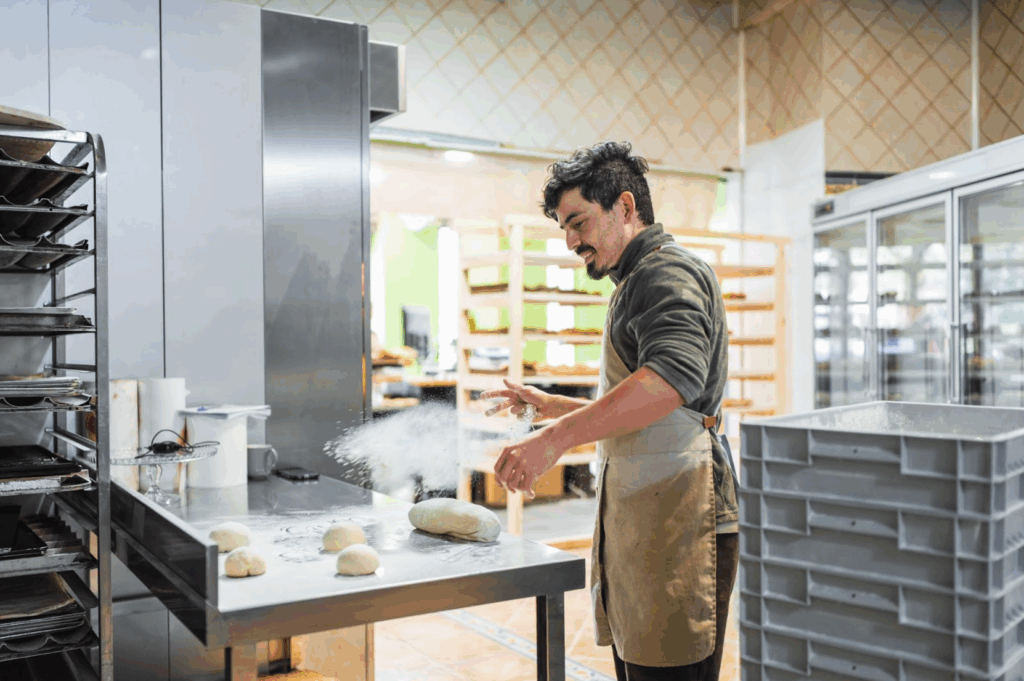Top Restaurant KPIs Every Restaurant Manager Should Track

Better data means better decisions. These 14 KPIs help restaurant managers work smarter, not harder.
Knowing your numbers is an operational superpower. If you want to run a tighter ship, train smarter, and spot trouble before it hits your bottom line, you have to track the right restaurant KPIs.
At MAJC, we’ve interviewed chefs and operators from across the country. These people have lived the chaos of service and still carved out sustainable, profitable businesses. They’re constantly thinking about the metrics that drive their teams, systems, and financial decisions. Throughout this guide, you’ll hear from a few of them.
In a fast-paced industry with razor-thin margins, it’s not about collecting all the data. It’s about tracking the right metrics and acting on them regularly. Here’s a look at the KPIs that matter most to restaurant managers, broken down into three buckets: financial health, operational efficiency, and guest experience.
Financial Health KPIs
These tell you if your restaurant is profitable or just busy.
1. Prime Cost
Your two biggest expenses: labor and ingredients. Combine them, and you’ve got prime cost. Keep this under 55% of sales to stay in the black.
Formula: Prime Cost = Cost of Goods Sold (COGS) + Total Labor Costs
2. COGS (Cost of Goods Sold)
Know exactly how much you’re spending on the food and beverages you sell. If this is creeping up, check your portions, waste, and purchasing habits.
Formula: COGS = Opening Inventory + Purchases – Closing Inventory
3. Labor Cost Percentage
High labor costs can quietly kill your profits. Use this KPI to spot scheduling issues, overstaffing, or inefficiencies.
Formula: Labor Cost % = (Labor Cost / Total Sales) × 100
4. Gross and Net Profit Margin
Gross margin tells you how well your menu is priced. Net margin tells you if the business model works at all.
Formula: Gross Profit Margin = (Sales – COGS) / Sales × 100
Formula: Net Profit Margin = Net Income / Sales × 100
“I wrote my first paycheck to myself during the pandemic, after 14 years,” said chef Maria Mazon of BOCA in Tucson. “Events, catering, anything I made went back into the restaurant to compete with big chains.”
5. Cash Flow
Plenty of profitable restaurants have closed because they ran out of cash. Track this regularly.
Formula: Cash Flow = Cash In – Cash Out
Operator Insight : Don’t Just Track These Monthly, Go Weekly if You Can
Monthly check-ins are good. Weekly reviews are better. Even if you’re short on time, start building fluency in reading and reacting to your numbers in shorter cycles. Patterns appear faster. Decisions get clearer. And your stress level? It drops.
Operational Efficiency KPIs
These help you run a tighter operation, boost productivity, and uncover waste.
6. Revenue per Available Seat Hour (RevPASH)
Want to maximize every seat? This metric shows how efficiently you’re using your space and time.
Formula: RevPASH = Total Revenue / (Seats × Hours Open)
7. Table Turnover Rate
More turns = more revenue. But move too fast and the guest experience suffers. Use this to find the sweet spot.
Formula: Table Turns = Total Parties Served / Number of Tables
8. Inventory Turnover
Too much inventory = waste. Too little = 86’ing bestsellers. This metric helps you strike the right balance.
Formula: Inventory Turnover = COGS / Average Inventory
9. Employee Turnover Rate
Hiring and training cost money. High turnover can wreck your culture and your bottom line.
Formula: Turnover Rate = (Employees Who Left / Average Number of Employees) × 100
“We built our leadership team with one goal: reduce turnover,” said Kevin Boehm, co-founder of Boka Restaurant Group. “If your people feel invested, they’ll stay. And if they stay, everything gets easier to manage, from margins to morale.”
10. Food Waste
Over-prep, spoilage, and plate waste add up fast. Reducing food waste directly improves margins.
Formula : Food Waste = Kitchen Waste + Plate Waste + Spoilage
Operator Insight: Focus on Contribution Margin, Not Just Prime Cost Tracking prime cost is critical, but it’s not the whole picture. To run a truly profitable menu, evaluate contribution margins, which is how much profit each dish actually contributes after food and labor costs.
This is where most operators miss out. They might hit their 55% prime cost target, but fail to push high-margin dishes, or keep underperformers on the menu too long. Look at contribution margin by dish and by daypart (breakfast, lunch, pre-theater, dinner, dessert). Use it to adjust menu design, pricing, and promotion.
Guest Experience KPIs
Because a packed restaurant doesn’t mean much if no one comes back.
11. Customer Satisfaction Score (CSAT)
Simple and effective. Ask guests to rate their experience. Use the feedback to train staff and improve service.
Formula: CSAT = (Positive Responses / Total Responses) × 100
12. Spend Per Head
See how much each guest spends on average. This helps with pricing, portion sizing, and upselling strategies.
Formula: Spend Per Head = Total Sales / Total Guests
13. Average Check Size
Another view of per-guest spending. Boost this with strategic menu design and server training.
Formula: Average Check = Total Sales / Total Transactions
14. Online Ratings and Reviews
Don’t sleep on this. Most guests check reviews before deciding where to eat. Monitor trends and respond thoughtfully.
How to Track : Aggregate reviews across Google, Yelp, OpenTable, etc., and calculate your average rating.
What to Do With This Data
Tracking restaurant KPIs helps you make smarter, faster decisions based on real numbers, not gut feelings. Here’s how to put your KPIs to work:
1. Spot Problems Early
KPIs are your early warning system. A sudden dip in RevPASH? It could mean service is slowing down. A spike in COGS? Maybe there’s waste in the kitchen or a purchasing issue. Use KPIs to catch cracks before they turn into craters.
Tip: Set weekly KPI benchmarks and compare them over time. You don’t need perfection, just patterns. When numbers move, dig into the “why.”
2. Coach Your Team, Not Just Correct Them
Data-backed coaching hits differently. Instead of saying, “You need to upsell more,” show a server their average check size compared to the team. Highlight top performers, recognize wins, and support team members who need help closing the gap.
Tip: Run weekly one-on-ones using server-specific KPIs like per person average (PPA), guest feedback, and error rates. Use the numbers to guide a real conversation, not a performance review.
3. Drive Smarter Menu Decisions
Your menu isn’t just a list. It’s a sales strategy. When you track menu-item profitability and food cost percentage, you can identify what to promote, rework, or cut.
Tip: Run quarterly menu audits. Use sales data, food cost, and prep time to decide what’s working and what’s dragging your margins down.
4. Dial In Staffing and Scheduling
Table turnover slow on Tuesdays? Labor cost creeping over 30% during brunch shifts? Use that data to build better schedules, optimize labor, and match your staffing to actual guest demand, not assumptions.
Tip: Pair RevPASH and labor cost by shift. Look for times when labor is high and revenue is low. That’s your cue to adjust schedules or cross-train staff.
5. Plan for Growth With Confidence
Want to expand hours, launch a new concept, or open another location? Don’t guess. Run the numbers. Historical sales trends, profit margins, and prime cost percentages will tell you if you’re running lean and strong or if there’s work to do before scaling.
Tip: Build a simple monthly KPI dashboard. Share it with leadership or investors to demonstrate operational discipline and long-term viability.
“In the early days, I had no idea who the IRS even was,” said Mazon. “I was working 18-hour days, running payroll, shopping for ingredients, and trying to survive. I’m proud of what I’ve built, but now I’m smarter. I’m tracking everything.”
6. Turn Data Into Culture
When KPIs become part of your team’s weekly rhythm, they stop feeling like metrics and start feeling like momentum. Celebrate when goals are hit. Talk openly when something’s off. Make improvement a shared mission, not a top-down mandate.
Tip: Post a “KPI of the Week” in the kitchen or break area, something simple like average check size, food waste, or table turns. Invite ideas for how to improve it. Keep it collaborative.
“The numbers have to mean something to your team,” said chef Gavin Kaysen. “If you’re not telling the story behind the data—what it means for them, for the restaurant, for the guest—it’s just noise.”
Bottom Line
Restaurant KPIs create clarity. They help you zoom out, see the big picture, and build a more resilient business. However, tracking KPIs isn’t just about the business. It’s about your bandwidth. When you understand what’s working (and what’s not), you spend less time firefighting and more time leading. That’s how you build a business that lasts without burning out.
Start small by picking three KPIs, and track them weekly. Talk about them with your team. Adjust where needed. Over time, these numbers become more than reports. They become your operational playbook.
Tracking the right numbers is just the start. Knowing what to do with them is what counts. Inside the MAJC community, restaurant leaders share how they use KPIs to improve performance, boost profitability, and make smarter decisions every week. Join here.
At MAJC, AI helps us organize thoughts and speed up workflows, but every article is shaped, refined, and approved by real people who live and breathe this industry. We think honesty (like hospitality) works best when it’s real.


